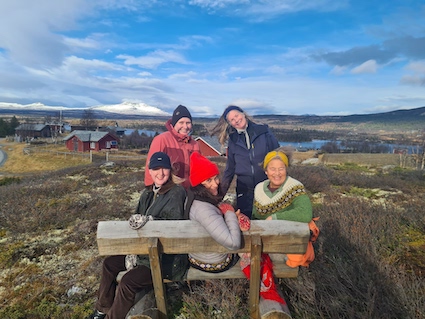Klippe, klippe, klippe: A changing discussion of gender

Part of the CHANGE team recently travelled to the mountains to have a meeting to discuss work in progress. A recurring theme was the Norwegian fairy tale about “Kjerringa mot strømmen” (The hag against the current). The one who even when being drowned by her husband after her insistence that the crop is cut with scissors not his preferred scythe, insists “klippe, klippe, klippe” (cut with scissors).
The group, during the discussion, both agreed about many things, and came up with new thoughts during the meeting, about men and women’s wardrobes and the necessity to discuss gender in the context of sustainability. There is little in our field of study that is not gendered, it concerns the clothes themselves, how they are used, who those of us who are actually studying clothes are and who our informants are. Nevertheless, gender is rarely an important part or even a discussion point in clothing and sustainability research. We talked about why this is so, and what we can do to change this.
In the study of clothing, gender is not the only thing missing, however, gender will always play a role, because we have different bodies and different life stories. Because clothing is physical, they will always relate to the gender in some way. We also discussed how gender is brought in to other areas, such as health, related also to smoking and drinking, and how our bodies tolerate things differently related to gender.
If we acknowledge that gender is a social construct, we still have to deal with bodies as physical. Because both of these conditions are complex and related, this presents additional challenges.
In studies and especially comparisons of men’s and women’s clothing, it is easy to describe the differences, and thus reinforce the stereotypes. We discussed how the stereotypes can removed or challenged, and thus not reinforced. We also revisited Thorstein Veblen’s theories about clothing, which can contribute to a better understanding of systems and power.
We talked briefly about what else is “missing” in the discourse around clothing and sustainability, including the class perspective.
All in all, this discussion pointed to a direction that is important to explore when it comes to different “black holes” or blind spots, that if left un-touched, may end up hampering rather than helping us move forward.
In the fairytale, the women was drowned sticking her hand up above the water making the “clipping” sign with her fingers. She would not give in. Afterwards they could not find her before someone suggested to search for her upstream. And yes, there she was. Kate added to this, that she always thinks it is good idea to look in the least expected direction. We need to remind each other about the limitations of the “obvious”.
